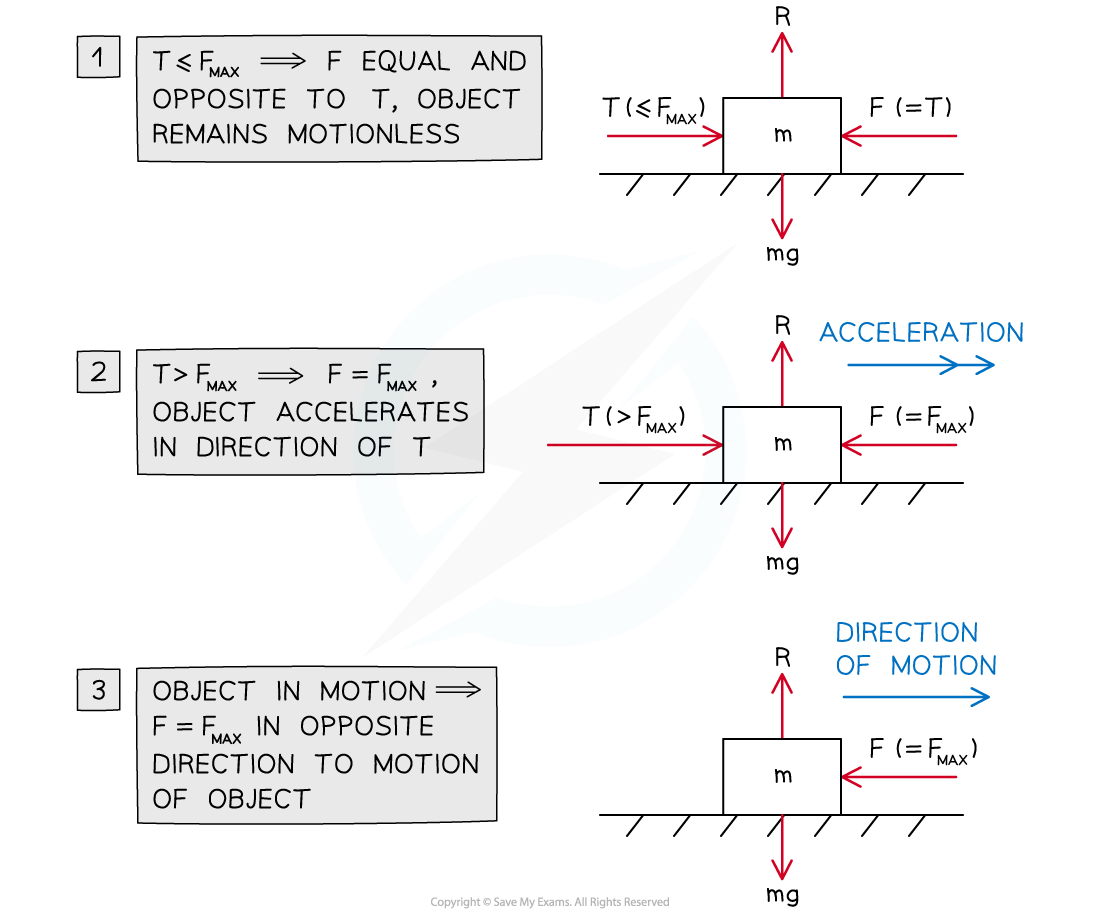3.3.2 Coefficient of Friction
Coefficient of Friction
What is friction?
- Friction is a force between a surface and an object that acts to resist motion of the object across the surface
- On a horizontal surface with no forces acting on a stationary object other than gravity and the surface's normal reaction force, there is no force of friction
- If an additional force acts on the object parallel to the surface then friction manifests as a force in the opposite direction
- Friction always acts in a direction parallel to the surface
- Friction acts in the opposite direction to the resultant force that would cause the object to move parallel to the surface
- Up to a certain limiting value (see next section) the force of friction prevents motion entirely
- Beyond that limiting value friction is a force of constant magnitude in the opposite direction to the motion of the object
What Is the coefficient of friction?
- The magnitude of the frictional force satisfies the inequality:
F ≤ μR
where F is the force of friction, R is the normal reaction force between the object and the surface, and μ is the coefficient of friction between the object and the surface
-
- If there is no friction then μ= 0 and the surface is smooth
- Otherwise μ > 0
- The maximum possible frictional force is given by the equation
FMAX = μR
where FMAX is the maximum possible force of friction, and R and μ are as above
- FMAX serves as a limiting value for mechanics problems involving friction
- If the object is stationary and the resultant of other parallel forces to the surface is less than or equal to FMAX then
- the object remains stationary
- the frictional force is always equal and opposite to the resultant of the other horizontal forces
- if the resultant of other horizontal forces is equal to FMAX then the object is said to be in limiting equilibrium
- If the object is stationary and the resultant of other horizontal forces becomes greater than FMAX then
- the object begins to accelerate in the direction of the resultant force
- the frictional force is equal to FMAX with a direction always opposite to that of the object's motion
- If the object is in motion parallel to the surface then (regardless of any other forces) the frictional force will always be equal to FMAX with a direction opposite to that of the object's motion
- If the object is stationary and the resultant of other parallel forces to the surface is less than or equal to FMAX then

Worked example

A box with a mass of 12 kg is at rest on a horizontal floor. The coefficient of friction between the box and the floor is 0.7. A horizontal force of 80 N is applied to the box. Describe the force of friction in this situation and determine whether or not the box will begin to move.

Exam Tip
- Always draw a force diagram and label it clearly.
- Look out for the words smooth and rough in mechanics problems involving an object moving (or potentially moving) along a surface:
- If the surface is described as smooth then you can ignore friction in the problem (ie μ= 0)
- If the surface is described as rough than you need to include the force of friction in solving the problem.
- If a friction question states that an object is on the point of moving that means that the object is in limiting equilibrium.

You've read 0 of your 0 free revision notes
Get unlimited access
to absolutely everything:
- Downloadable PDFs
- Unlimited Revision Notes
- Topic Questions
- Past Papers
- Model Answers
- Videos (Maths and Science)
Did this page help you?
